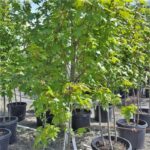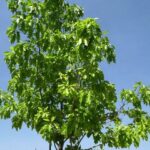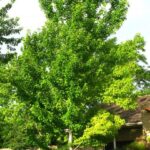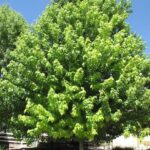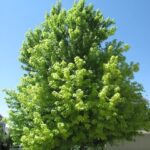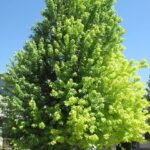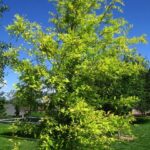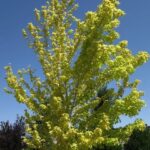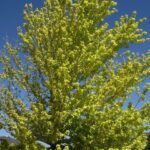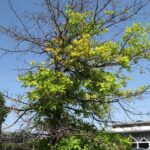IRON CHLOROSIS TREATMENT
Iron Deficiency In Trees
When a tree is suffering from an iron deficiency and has become chlorotic, this can be very frustrating to watch the tree turning yellow and slowly dying. If the tree is not responding to deep root tree fertilization treatments we have a very effective treatment called Tree IV, which will start the tree functioning again. The Tree IV treatment forces a heavy dosage of iron and manganese into the truck of the tree and allows the tree to start producing chlorophyll again.
The way the Tree IV system works is similar to an IV for a human. We start by drilling a few 1/4 inch holes in the tree’s trunk; near the base of the tree. These holes do not cause irreparable damage to the tree. We then attach injection plugs into the holes and place the injection needles into the tree’s trunk. Using air pressure, we inject a liquid mix of chelated iron and magnesium directly into the xylem layer of the tree. The tree has no choice other than to accept the liquid concentrate of iron and magnesium.
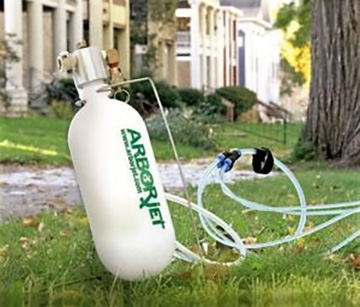
Organo-Lawn uses a special tree IV kit to force the tree to uptake the iron treatment. Boulder and Fort Collins area trees tend to live in clay-like soils which causes iron chlorosis.
Tree IV Iron Injection for Severe Chlorosis: $97.00 Minimum Charge. Get Free Estimate
Chlorotic vs Normal Maple Leaves
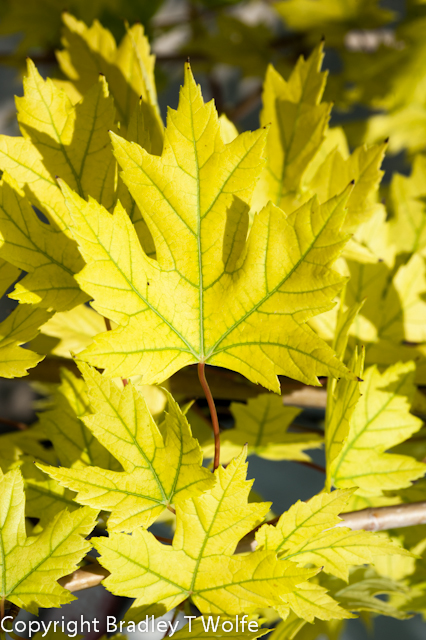
This Maple leaf is Chlorotic.
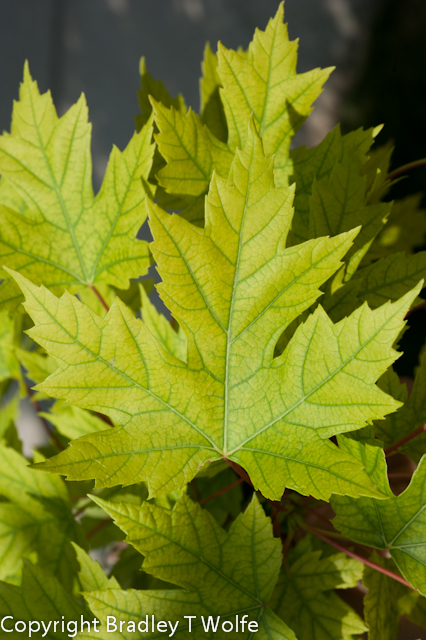
This Maple leaf is minority Chlorotic.
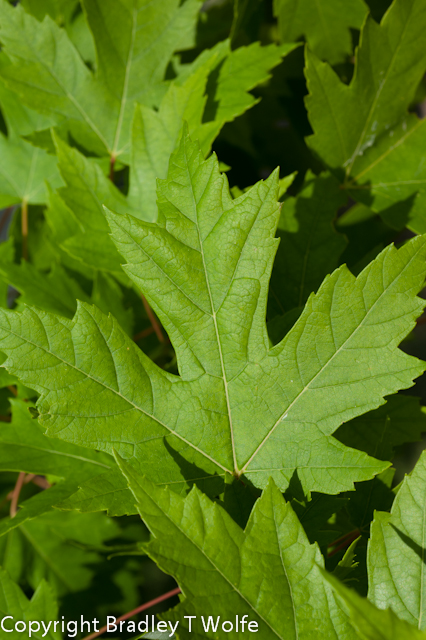
This Maple leaf is healthy.
What are the Different Stages of Iron Chlorosis
Click on an image below to enlarge.
Tree is green but losing color, pale green.
Approx. Years Until Death: 10-15
99% chance of recovery
This Oak tree is green but losing color, light green with the beginning of veins
Approx. Years Until Death: 9-10
99% chance of recovery
This maple tree is yellowing, on one or two branches the leaves are turning yellow on the south side.
Approx. Years Until Death: 8-9
99% chance of recovery
This maple tree is yellowing, on one or two branches the leaves are turning yellow on the south side.
Approx. Years Until Death: 7-8
99% chance of recovery
This maple tree is yellow, 20-40% of the tree’s branches are yellow
Approx. Years Until Death: 6-7
99% chance of recovery
This maple tree is significantly yellow, 40-75% of the tree is yellow
Approx. Years Until Death: 5-6
95% chance of recovery.
This oak tree is obviously yellow, 75-95% of the tree is very yellow
Approx. Years Until Death: 4-5
90% chance of Recovery if it is an Oak and 60% if it is a Maple tree.
100% of this maple tree is very yellow and the leaves are very pale
Approx. Years Until Death: 3-4
80% chance of Recovery if it is an Oak and 50% if it is a Maple tree.
100% of this maple tree is yellow and a few of the branches are dropping leaves.
Approx. Years Until Death: 2-3
40% chance of Recovery if it is an Oak and 20% if it is a Maple tree.
100% of this oak tree is yellow and/or 50% or more of the branches don’t have leaves
Approx. Years Until Death: 1-2
10-15% chance of Recovery if it is an Oak and 5-10% if it is a Maple tree.
Plan for Bringing a Chlorotic Tree Back to Health
Iron Chlorosis for Maple and Oak Tree
Oak trees respond very quickly when treated for chlorosis while maple trees may take many years to improve. There are many factors that speed up the recovery of a struggling tree. We have found a combination of Tree IV, deep root tree fertilization, and making sure the lawn and trees are being watered according to the 1-2-3-2-1 lawn watering technique will help speed up the recovery of the tree.
Step 1
A sprinkler system audit is a must do to make sure that the tree is being watered according to the 1-2-3-2-1 lawn watering technique. Over watering replaces air in the soil, which can starve the roots of oxygen and kill beneficial microbial activity in the soil. Watering a lawn daily will kill microbes in the soil and will promote shallow digging tree roots. The ideal way to water a lawn is deeply and infrequently, allowing the ground to dry out between watering.
Step 2
Have a Tree IV using iron and manganese performed by Organo-Lawn. This will start the tree functioning again, but this is not a permanent solution to the problem.
Step 3
Deep Root Tree Fertilization should be performed both spring and fall by Organo-Lawn using only our all organic tree fertilizer. This will obviously fertilize the tree but it will also add vital nutrients to the surrounding soil and stimulate beneficial microbial activity.
Important Note: Oak trees tend to recover from chlorosis much faster and easier than maple trees. It is not uncommon for an oak tree to recover in one season or less and a maple tree can take 5 or more years to fully recover.
Tree IV for Iron Chlorosis Prices*
Tree Trunk Breast Height Diameter –
Cost Per Tree
3″ – 7″ – $97.00
8″ – $107.50
9″ – $115.00
10″ – $128.00
11″ – $134.50
12″ – $147.00
13″ – $159.50
14″ – $172.00
15″ – $184.50
16″ – $197.00
17″ – $211.50
18″ – $224.00
19″ – $236.50
20″ – $249.00
21″+ – Call for Pricing
Discounts: 5% off between $200-$300, 10% off between $300-$500, and 15% off for $500+
Chlorosis Treatment for Maple and Oak Trees
How Long Does It Take for the Tree to Recover from Chlorosis?
The tree’s recovery will be proportional to how severely deficient the tree is at the time of treatment and the species of tree. The response time to the IV treatment can be very rapid or can be very slow depending on the overall health of the tree.
Oak trees respond very quickly to the iron treatments while maple trees tend to take more time to improve. Noticeable greening and improved vitality will often be obvious within the growing season and sometimes within weeks after the application. We tend to see faster improvement with trees that are suffering from minor chlorosis (Stage 3-5). Severely chlorotic trees (Stages 6-10), larger trees or older trees will show a slower response and a second application might be necessary.
With older trees we often see results the following year which means the tree will not turn green the year of the application; however, the following year the leaves will typically bud out much greener and healthier.
Important: Tree IV is not a permanent fix to the problem. The main problem is the soil around the tree is dead and needs to be returned to a healthy and living state. To do this changes will need to be made with the watering and here are some instructions on how to create a living soil.
We strongly recommend changing the lawn watering to follow the 1-2-3-2-1 lawn watering technique. We have found a very strong correlation between improper lawn watering and iron deficiency in trees. The 1-2-3-2-1 lawn watering technique is the ideal way to water both the lawn and trees.
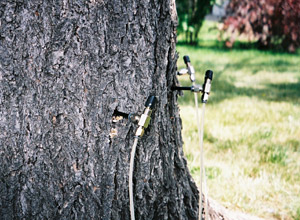
These are the needles that are used to inject the tree with the iron and manganese solution.
Before and After Photos of a Red Oak Tree
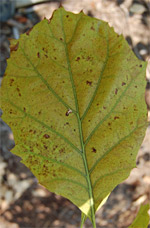
Before Treatment
Yellow leaves with green veins.
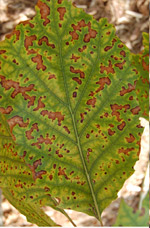
1 Week After Tree IV:
Notice the veins turning green and the iron burn on the leaf.
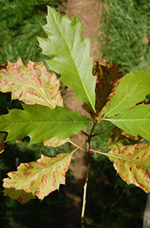
3 Months After Tree IV:
Notice how the
new growth is green vs the old growth.
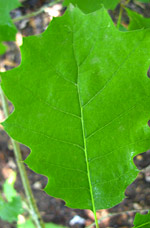
1 Year After Tree IV:
The leaf is a much darker green and healthy.
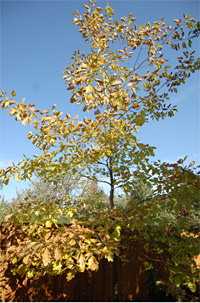
Before Tree IV:
The tree is yellow and unhealthy.
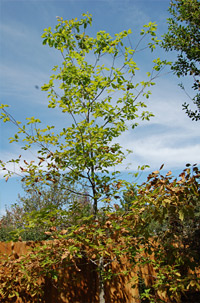
3 Weeks after Tree IV:
The leaves are turning green and some iron burn on the lower branches.
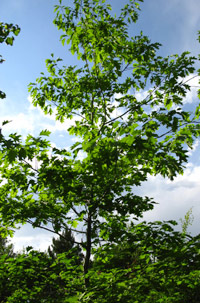
One Year After Tree IV:
The oak tree has recovered and the leaves are green and the tree is healthy.
FAQ – Iron Deficiency in Trees
What causes Iron Chlorosis in Oak and Maple Trees?
Usually the main cause of iron deficiency in tree is soils that lack organic matter and beneficial microbial activity. Iron Chlorosis is a yellowing of plant leaves caused by iron and manganese deficiency. The primary symptom of iron deficiency is iron chlorosis, the development of a yellow leaf with a network of dark green veins. This problem affects many desirable landscape plants in Colorado, especially oak and maple trees. Chlorosis could be caused from one or many of the following: dead soils, improper planting (usually too deep), over watering, air or soil pollution, improper drainage, landscaping damage, or other factors
